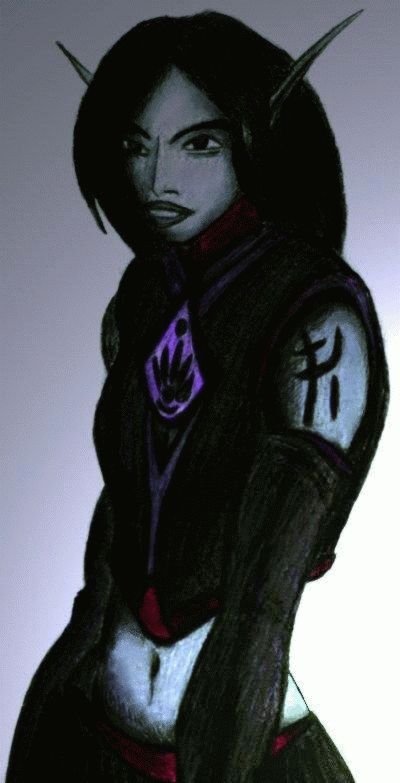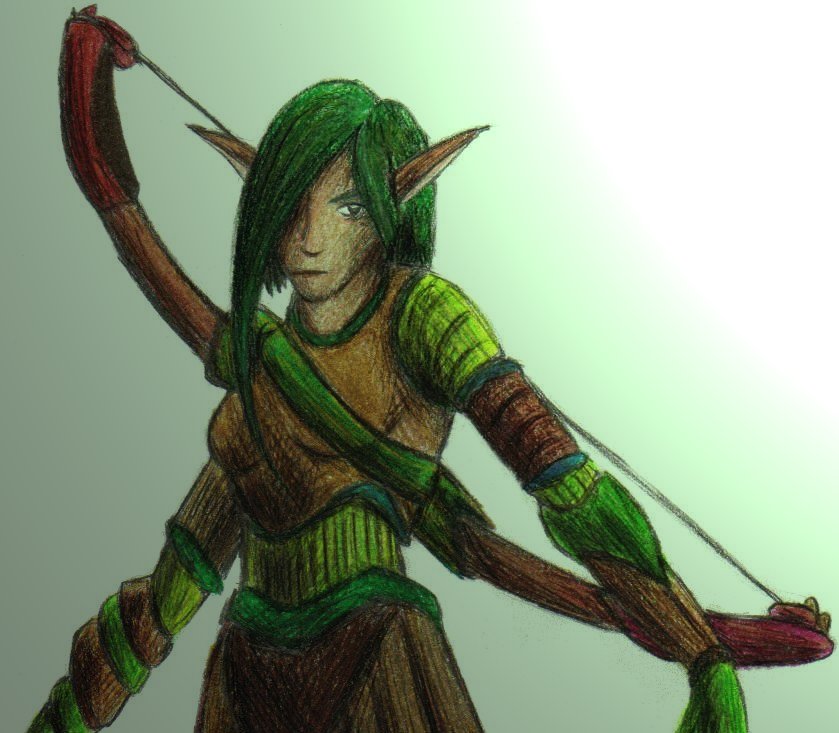 |
| The Elves The Elves were the original dominant race in the world. Their kingdoms covered all of Yendor, Sorell and Alalsil. Humanity was a collection of second-class citizens living on Alalsil, with the elves not even bothering to acknowledge their existence. The dwarves coexisted with the elves, although the "Short Ones" kept to themselves in their mountains and away from the elves' notorious wars. The reason for the elves' dominance was a very simple one: They had magic and no one else did. The elves credited this to their pantheon of nine living goddesses and one dead goddess who had blessed their pointy-eared creations. There is only one gender for the elves, and all are referred to as if they are female. Originally they conceived through unknown means, supposedly done through divine intervention. Their religion is based around reincarnation; when an elf died, another elf would become pregnant. The elvan population was very, very stable for eons. The most curious thing about elves is that they are virtually immortal. While they can be killed, they never age after the first twenty years of their lives. Unless they have an unfortunate run-in with a dragon, get incurably ill or pick the wrong fight, they can live forever. Because of the elves' warlike culture, this is not exactly possible. For reasons theologists, historians and scientists will be debating forever, elves somehow lost their magical powers around the same time humanity first discovered theirs. The elvan priestesses could no longer speak with the gods. Their entire civilization and culture was thrown into chaos. During the Dungeon Wars, the elves were forced to Yendor. This is also when their "holy wars" began. Currently, only five races of elves exist from the original nine. |
 |
| Red Elf The Red Elves are the most warlike of the Elvan Races, and that says quite a lot. Their culture as a whole has moved away from religious devotion to a perpetual state of war and propaganda. Soldiers and fighters are glorified and every war is a total war. Priestesses have become an upper class of generals and commanders. Their concept of their patron goddess has, as can be expected, also evolved; they now follow a goddess that is covered in the blood of her enemies, whose followers are red to reflect this grisly image. The Red Elves rely on durable metal mesh armor and "woodleather" for protection. Their weapons of choice are a Fire Staff (a fireball-producing weapon) or some like device. They rarely use conventional weapons unless as a last resort. Most have a short sword somewhere on their person. The general tactic is take the enemy out from as far away as possible. |
 |
| Blue Elf The Blue Elves live in marshes and near other bodies of water. Their religion has developed to believe that the universe started out as a vast primordial sea in which the world emerged. By staying close to the water, or living in knee-deep water, they are keeping close to their origins. Their armor is a combination of natural and blessed items turned into leather-like material. They use small wand- or cane-like objects topped with magic orbs for battle. The Blue Elves like to fight at home, on their own territory, where the water itself can be used against their enemy. This has led to a rather isolated society and culture, moreso than even the other elves. They are generally peaceful and do not seek out conflicts like the other elves do. The common belief is that it would best if the other elves just kill each other off and spare the Blue Elves the trouble. |
 |
| White Elf The White Elves are considered to the most advanced of the remaining Elvan Races. Their massive and fortified cities are legendary. Hovering public transportation and a complete lack of both crime and disease are only some of the White Elves' accomplishments. Their freedom from illness is not as remarkable as it may sound -- the White Elves originally had Life Magic, and most of their magical devices involve healing and health. Protective magical gems are on all their armors, which does more to defend them from harm than the armor itself. Short capes and similar articles of clothing are common; these supposedly enhance their speed and agility through some magical means. White Elves like to hit their enemies hard and fast, killing as many as possible in the first few minutes and then weeding out survivors. Because they can use their magical devices to heal themselves, they are not afraid to charge head-first at the enemy. Close-quarters combat is their specialty, and they can be quite savage when they want to be. |
 |
| Green Elf The Green Elves live in the forests and natural beauty of Yendor. Their settlements are either mobile or relatively primitive-looking. They live a nomadic life style and rarely stay in the same spot for too long. There may be some religious significance to this, but they are secretive about their faith and patron goddess. Green Elves like to attack from a distance and use surprise to their advantage. They will make hit-and-fade runs against their enemies to weaken them before "going in for the kill." Magically-enhanced arrows are their weapon of choice. They prize and push the skill of archery; many of them carry a bag of holding on their leg, allowing them to easily draw a seemingly endless supply of ammunition for their bows. A fondness for poisons and other potions is also characteristic of the Green Elves. |
 |
| Grey Elf The Grey Elves, the original masters of Hand Magic, are a husk of their former selves. Their kingdom was destroyed by a very short-lasting alliance between the White Elves and the now-extinct Yellow Elves. Despite this, the Grey Elves have refused to just go away. They exist underground -- not literally, of course -- as a network of spies and informants that keep tabs on everything the Elvan Races do. They partially still exist because they are useful. Everyone except the dwarves seem to have informants within the Grey Elf community; everyone. This includes the other four races of elves and both the New and Old Orders. The Grey Elves have mastered a forgotten and secretive art called marking. This involves burning and then inking symbols onto a person or thing in a quasi-religious ritual. These symbols enhance the skills of the wearer, making them faster or stronger or something to that effect. The symbol on most of their armor is the Hand of the Third Goddess; the wearer of the armor gains immediate teleporting abilities. So far, no other race or organization has figured out how marking works -- and the Grey Elves would like to keep it that way. During the current conflict, the Greys are divided into two main camps: One assists the New Order while the other helps the Old Order. There is no conflict between these two groups, but they have made clear divisions and these alliances may become lasting. Then again, no alliances the Greys hold ever last for more than a few years..... |

